
Chapter 12
Enhancing the human brain
Cafes, objects and parallel worlds
Working within the environment of the Internet, there can be far too many possible contacts for our brain to cope with efficiently. We need help to remember all the names and the different ways in which different people might be of interest to us. We need an efficient way to bring the right contacts to our attention whenever there is a need for particular assistance or information. Such help can be arranged by making appropriate use of the computer.
As humans and computers have totally different ways of dealing with information, an interface is necessary for humans and computers to be able to communicate with each other. Computers communicate across this interface using sound and visual images on a screen; humans by using a keyboard and mouse.
As most humans cannot communicate with computers at a programming level, the interface has to take the form of a metaphor of something that a human can easily relate to in the real world. Clever programming and graphics can create these metaphors and translate the human interactions into the binary language that computers can understand.
The virtual cafe is such a metaphor. It is a conceptual image that helps in the handling of a large number of Internet contacts. After all, it is far easier to think of inviting people into a cafe to have discussions than to think about a complex environment of records and algorithms. This is illustrated in figure 12.12, where an auteur (director of operations) or an entrepreneur visualises themselves in a cafe where, at the various tables, sit the contacts they need to help them create an e-business.
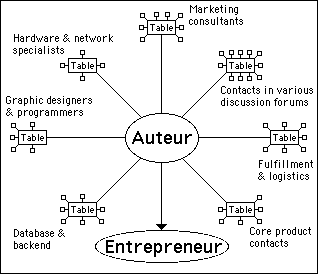
Figure 12.12
This is how the cafe might appear to an auteur or entrepreneur whose contacts are selected to help create an e-business
An on-screen representation of a virtual cafe may look quite different from the mental model carried by the auteur. It might consist of a list of contacts and a means of bringing selected people into a "cafe" area, which may be represented as a grid. Particular choices of people selected to sit at "tables" would be names highlighted in this grid. Such a screen view of a cafe is shown in figure 12.13.
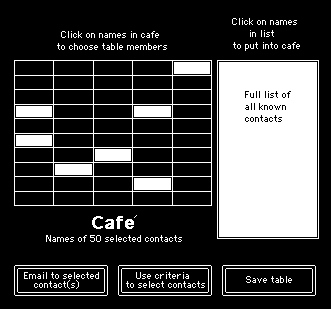
Figure 12.13
On screen view of a table being created in a virtual cafe
In reality, the virtual cafe is a sophisticated database. Each listed contact name is created as a record. Software objects can search these records to find people whose interest or knowledge coincides with any particular subject the cafe owner is interested in discussing.
Each record in the cafe database will contain a list of attributes and characteristics that have been assigned to a particular contact. Effectively, these records are clones of the contacts, representing who they are, what they know and what makes them interesting. Seeing these records as clones of the people they represent, it is then only a short step to think of these individual records as separate files that can exist independently of the database. As separate files, they can be sent to a software object, which can then send them to a Web site or include them in an e-mail to send to other people.
Visualising these records as transportable clones, if a person created a record of their own characteristics, they could send this record to their friends and contacts. Figure 12.14 illustrates such a facility that might be included with the virtual cafe software to enable cafe owners to make a clone record of themselves that they can send out to all their contacts.
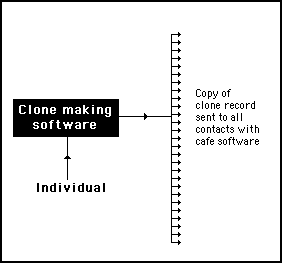
Figure 12.14
An individual, with a small software application for creating clone records, can send copies to all friends and contacts
Such a cloned record, would be created similar to the way in which the clones were created in the match making experiment previously described. People would simply answer some form of questionnaire – with the questions chosen to relate to a specific area of interest depending upon the purpose of the clone.
If the people who receive a clone record also have a virtual cafe – with a software object that can insert clones records into their virtual cafe's database – it would save them the trouble of entering that clone owner's details themselves. Figure 12.15 illustrates a cafe with an object that can accept clone records from other people and insert them into a virtual cafe's database.
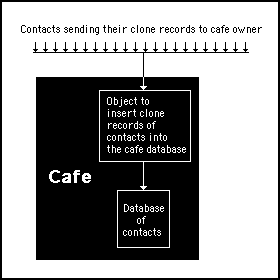
Figure 12.15
A virtual cafe with a software object that can insert clone records into its database
A software object on the client side can also be designed to transfer clone records to a Web site. This is illustrated in figure 12.16, where an individual creates a clone record of him of herself which is then passed to an object that will send it to a Web site. In this way, it can be arranged for many different cafe owners to send their clones records to particular meeting places in a people space (which might exist as a file on a Web site). Such gathering of clone records can be organised completely from the client side by the cafe owners themselves without the server side having to be involved at all (other than to facilitate the inclusion of a clone record in the designated file).
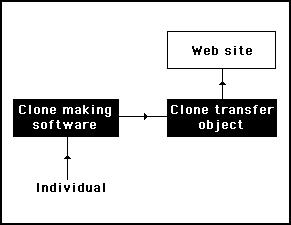
Figure 12.16
Individuals can make clone records of themselves that can be sent to designated Web sites. If the Web site is a people space, these clone records can be sent to selected meeting places
If cafe owners have objects that can send their clone records to a particular meeting place in a people space, they can equally have objects that download the clones at a meeting place into a virtual cafe in their own computer. This is illustrated in figure 12.17, where one object downloads copies of the clone records at a particular meeting place, then passes these to another object to insert into the cafe database.
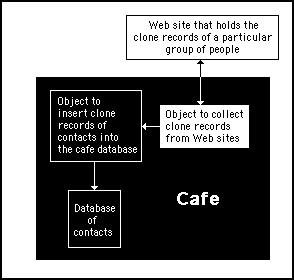
Figure 12.17
An object can download the clone records of a particular group of people and pass them to another object to insert into the virtual cafe database
In the match making experiment I tried out in my home town, people had to physically go to the meeting places in real life to make their final personal selections. In this virtual world, the meeting place can be transferred to everyone's own computer: for them to inspect the clone records of everyone else and decide who to make actual contact with.
Just as in real life meeting places, one to one communications can take place or small groups can be brought together for discussions. The big difference is that every person has their own personal copy of the meeting place and can use it in any way they wish. It is this aspect of virtual meeting places that is so difficult to comprehend because there is no equivalent of this situation in the world of bricks and mortar.
The conceptual jump is to get away from the idea of there being a single meeting place and imagine each meeting place as being duplicated in a number of parallel worlds: where the interactions may take all kinds of different forms and directions. This may seem like something out of science fiction, but, it is through understanding the bizarre and counter intuitive nature of the Internet that breakthroughs can be made.